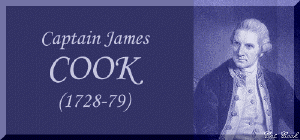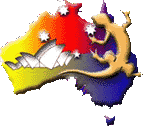|
    |
Cook, popularly called Capt. Cook, was born in Marton, England, the son of a farm laborer. After spending his early years as an apprentice with a firm of shipowners, he enlisted in the British navy in 1755. Within four years he had become a master, and he spent the years 1756 to 1767 charting the North Atlantic coastal waters off Newfoundland and Nova Scotia and the Saint Lawrence River below Quebec. In 1768, as lieutenant in command of the Endeavour, he undertook his first great voyage to the South Pacific, on which he safely carried a group of British astronomers to the recently discovered island of Tahiti to observe the transit of the planet Venus across the sun in June 1769. He then proceeded to New Zealand, taking formal possession of parts of both main islands and accurately charting 3860 km (2400 mi) of coastline for the first time. In 1770 he discovered the eastern coast of Australia, which he charted and claimed for Great Britain under the name of New South Wales. On his return to England in 1771 Cook was promoted to the rank of commander. In 1772, in command of the Resolution, and accompanied by another ship, the Adventure, he set out on his second great expedition, a search for the fabled southern continent, Terra Australis, of which Africa was thought to be a part. He entered the South Pacific, where he sailed along the edge of the Antarctic ice block; on Jan. 16, 1773, he made the first crossing of the Antarctic Circle. In 1773 he discovered the islands that were named after him. In 1774 he charted the New Hebrides, the Marquesas, and Easter Island, and discovered several Pacific Islands, including New Caledonia and Niue. After his return to England in July 1775, Cook was made a fellow in the Royal Society and was awarded the Copley medal for scientific achievement. His great 3-year expedition had proved that no southern continent existed, only the great ice mass of the Antarctic region; the voyage was also notable for the remarkable health record maintained by the crew. Cook's insistence on proper hygiene and diet greatly reduced the number of scurvy cases during the expedition. In July 1776, Cook sailed again to determine whether a Northwest Passage between the Atlantic and Pacific oceans existed north of the North American continent. During the first part of the expedition he again visited the mid-Pacific, discovering and charting in the early part of 1778 some of the Sandwich Islands, which were later renamed the Hawaiian Islands. Reaching the coast of the North American continent, off the coast of present-day Oregon, he searched in vain for a Northwest Passage, charting the western coastline as far north as the Bering Strait, where ice turned him back. He then returned to the Sandwich Islands, where he was killed during a skirmish with islanders over the theft of a boat. Copyright unknown
|
|
|
|
[ Virtual
Australia | The
World We Live In | The
Things We Do ]
Problems/Broken Links can be reported
to
All text and
graphics unless otherwise stated are ©1998-2000 Kim Holden, Virtual Australia.
|

![[Visit Oska]](../../images/oska003.gif)
